Analysis of the Influence of Thickness and Density on Acoustic Absorption of Materials Made from Used Cigarette Butts
Abstract
:1. Introduction
2. Materials and Methods
2.1. Preparation of Samples
2.2. Instrumentation for Acoustic Absorption Determination
3. Results and Discussion
3.1. Analysis of the Influence of Compaction of the Samples on Their Acoustic Behavior
3.2. Influence of the Thickness of the Samples
4. Conclusions
Author Contributions
Funding
Institutional Review Board Statement
Informed Consent Statement
Data Availability Statement
Conflicts of Interest
References
- Ariza, E.; Jiménez, J.A.; Sardá, R. Seasonal evolution of beach waste and litter during the bathing season on the Catalan coast. Waste Manag. 2008, 22, 2604–2613. [Google Scholar] [CrossRef]
- Martínez-Ribes, L.; Basterretxea, G.; Palmer, M.; Tintoré, J. Origin and abundance of beach debris in the Balearic Islands. Sci. Mar. 2007, 71, 305–314. [Google Scholar] [CrossRef]
- Moriwaki, H.; Kitajima, S.; Katahira, K. Waste on the roadside, ‘poi-sute’ waste: Its distribution and elution potential of pollutants into environment. Waste Manag. 2009, 29, 1192–1197. [Google Scholar] [CrossRef] [Green Version]
- Euromonitor International. Passport: Global Market Information Database. 2016. Available online: https://tobaccoatlas.org/topic/consumption/ (accessed on 27 July 2021).
- Available online: https://es.statista.com/estadisticas/636021/consumo-mundial-de-cigarrillos/#statisticContainer (accessed on 27 July 2021).
- Novotny, T.E.; Slaugther, E. Tobacco Product Waste: An Environmental Approach to Reduce Tobacco Consumption. Curr. Environ. Health Rep. 2014, 1, 208–216. [Google Scholar] [CrossRef] [Green Version]
- Puls, J.; Wilson, S.A.; Hölter, D. Degradation of Cellulose Acetate-Based Materials: A Review. J. Polym. Environ. 2011, 19, 152–165. [Google Scholar] [CrossRef] [Green Version]
- Slaughter, E.; Gersberg, R.M.; Watanabe, K.; Rudolph, J.; Stransky, C.; Novotny, T.E. Toxicity of cigarette butts, and their chemical components, to marine and freshwater fish. Tob. Control 2011, 20, i25–i29. [Google Scholar] [CrossRef]
- Micevska, T.; Warne, M.S.J.; Pablo, F.; Patra, R. Variation in, and Causes of, Toxicity of Cigarette Butts to a Cladoceran and Microtox. Arch. Environ. Contam. Toxicol. 2006, 50, 205–212. [Google Scholar] [CrossRef]
- Lee, W.; Lee, C.C. Development toxicity of cigarette butts-An underdeveloped issue. Ecotoxicol. Environ. Saf. 2015, 113, 362–368. [Google Scholar] [CrossRef]
- World Health Organization. Tobacco and Its Environmental Impact: An Overview; World Health Organization: Geneva, Switzerland, 2017. [Google Scholar]
- Loan, T. Cigarette Waste: New Solutions for the World’s Most-Littered Trash. Pollution & Toxins. 2019. Available online: https://therevelator.org/cigarette-butt-litter-solutions/ (accessed on 28 July 2021).
- Terracycle, Cigarettte Waste Recycling Program. Available online: https://www.terracycle.com/en-US/brigades/cigarette-waste-recycling (accessed on 28 July 2021).
- Torkashvand, J.; Farzadkia, M. A systematic review on cigarette butt management as a hazardous waste and prevalent litter: Control and recycling. Environ. Sci. Pollut. Res. 2019, 26, 11618–11630. [Google Scholar] [CrossRef]
- Marinello, S.; Lolli, F.; Gamberini, R.; Rimini, B. A second life for cigarette butts? A review of recycling solutions. J. Hazard. Mater. 2020, 384, 121245. [Google Scholar] [CrossRef]
- Mohajerani, A.; Hui, S.Q.; Shen, C.; Suntovski, J.; Rodwell, G.; Kurmus, H.; Hana, M.; Rahman, M.T. Implementation of Recycling Cigarette Butts in Lightweight Bricks and a Proposal for Ending the Littering of Cigarette Butts in Our Cities. Materials 2020, 13, 4023. [Google Scholar] [CrossRef]
- Gómez Escobar, V.; Maderuelo-Sanz, R. Acoustical performance of samples prepared with cigarette butts. Appl. Acoust. 2017, 125, 166–172. [Google Scholar] [CrossRef]
- Maderuelo-Sanz, R.; Gómez Escobar, V.; Meneses-Rodríguez, J.M. Potential use of cigarette filters as sound porous absorber. Appl. Acoust. 2018, 129, 86–91. [Google Scholar] [CrossRef]
- Gómez Escobar, V.; Rey Gozalo, G.; Pérez, C.J. Variability and Performance Study of the Sound Absorption of Used Cigarette Butts. Materials 2019, 12, 2584. [Google Scholar] [CrossRef] [Green Version]
- Maderuelo-Sanz, R. Characterizing and modelling the sound absorption of the cellulose acetate fibers coming from cigarette butts. J. Environ. Health Sci. Eng. 2021, 19, 1075–1086. [Google Scholar] [CrossRef] [PubMed]
- Maderuelo-Sanz, R.; Nadal-Gisbert, A.V.; Crespo-Amorós, J.E.; Parres-García, F. A novel sound absorber with recycled fibers coming from end of life tires (ELTs). Appl. Acoust. 2012, 73, 402–408. [Google Scholar] [CrossRef]
- Maderuelo-Sanz, R.; Morillas, J.M.B.; Gómez Escobar, V. Acoustical performance of loose cork granulates. Eur. J. Wood Prod. 2014, 72, 321–330. [Google Scholar] [CrossRef]
- Khan, A.; Mohamed, M.; Al Halo, N.; Benkreira, H. Acoustical properties of novel sound absorbers made from recycled granulates. Appl. Acoust. 2017, 127, 80–88. [Google Scholar] [CrossRef] [Green Version]
- Martellotta, F.; Cannavale, A.; De Matteis, V.; Ayr, U. Sustainable sound absorbers obtained from olive pruning wastes and chitosan binder. Appl. Acoust. 2018, 141, 71–78. [Google Scholar] [CrossRef]
- Martellotta, F. Innovative Composite Materials for Sound Absorption and Insulation: Where We Are and Where We Are Going. Materials 2021, 14, 1954. [Google Scholar] [CrossRef]
- Gómez Escobar, V.; Moreno González, C.; Arévalo Caballero, M.J.; Gata Jaramillo, A.M. Initial Conditioning of Used Cigarette Filters for Their Recycling as Acoustical Absorber. Materials 2021, 14, 4161. [Google Scholar] [CrossRef]
- ISO 10534-2. Acoustics: Determination of Sound Absorption Coefficient and Impedance in Impedances Tubes. Part 2: Transfer-Function Method; International Organization for Standardization: Geneva, Switzerland, 1998. [Google Scholar]
- Dormann, C. Parametrische Statistik. Verteilungen, Maximum Likelihood und GLM in R; Springer: Berlin/Heidelberg, Germany, 2017. [Google Scholar]
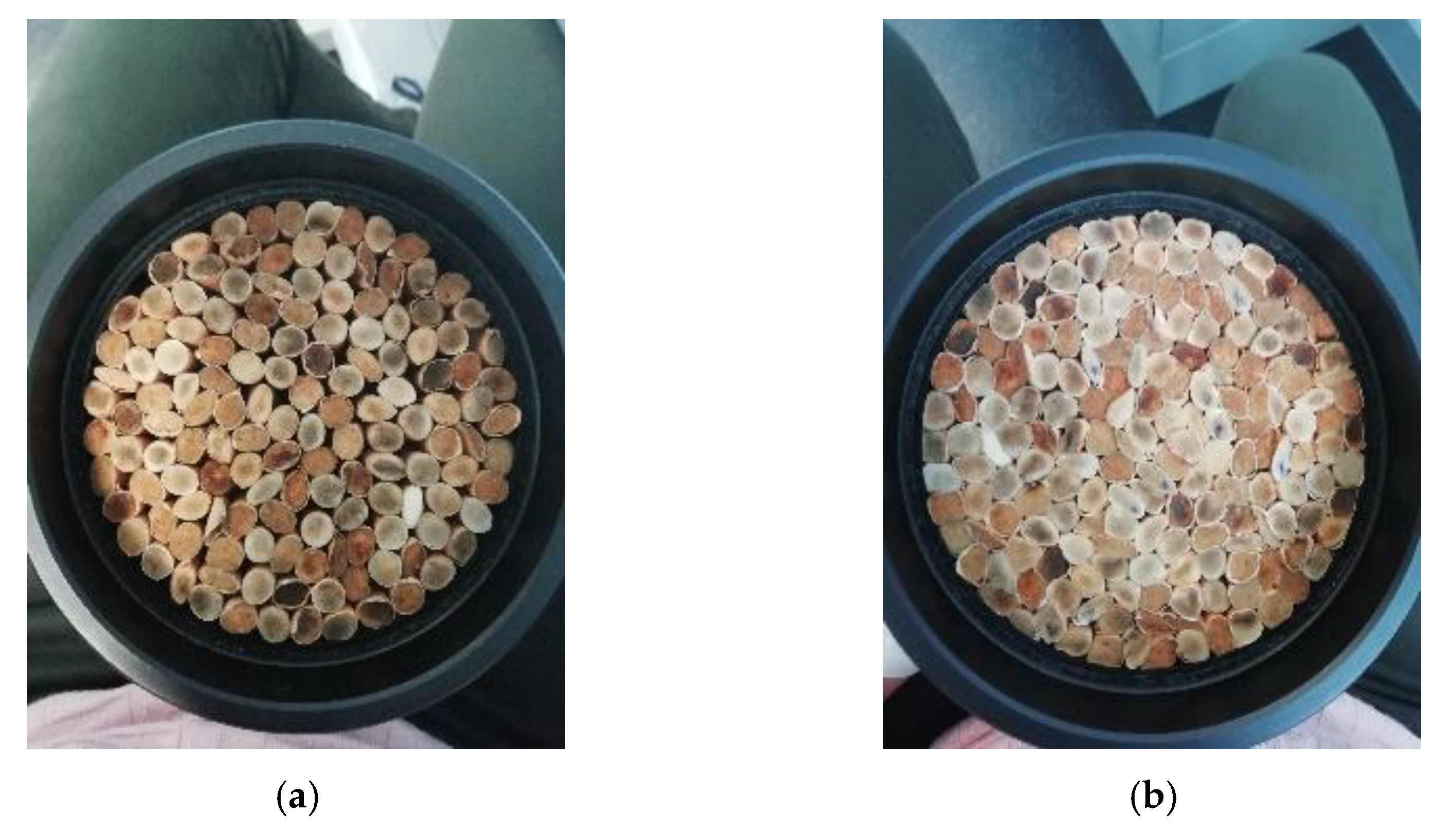

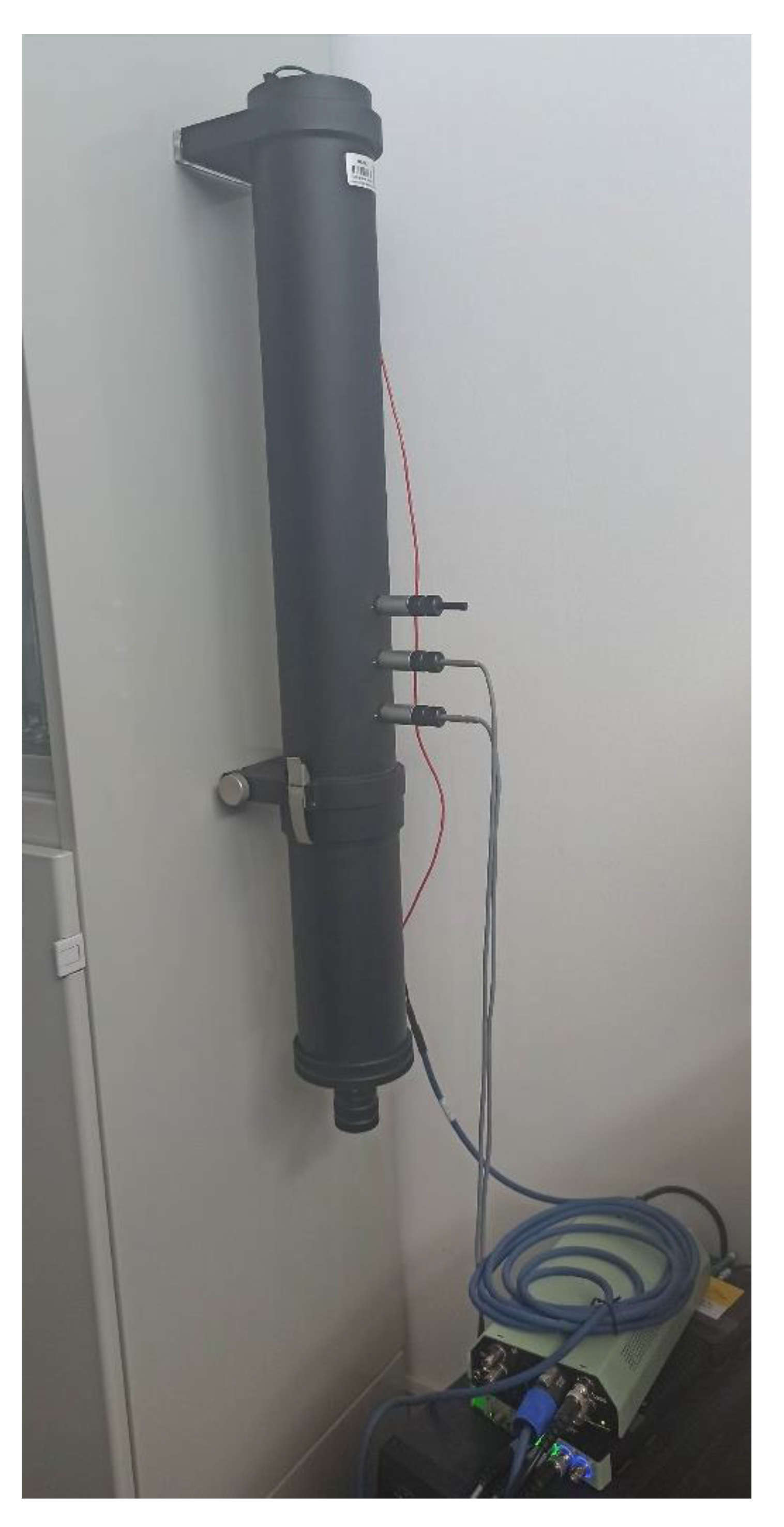
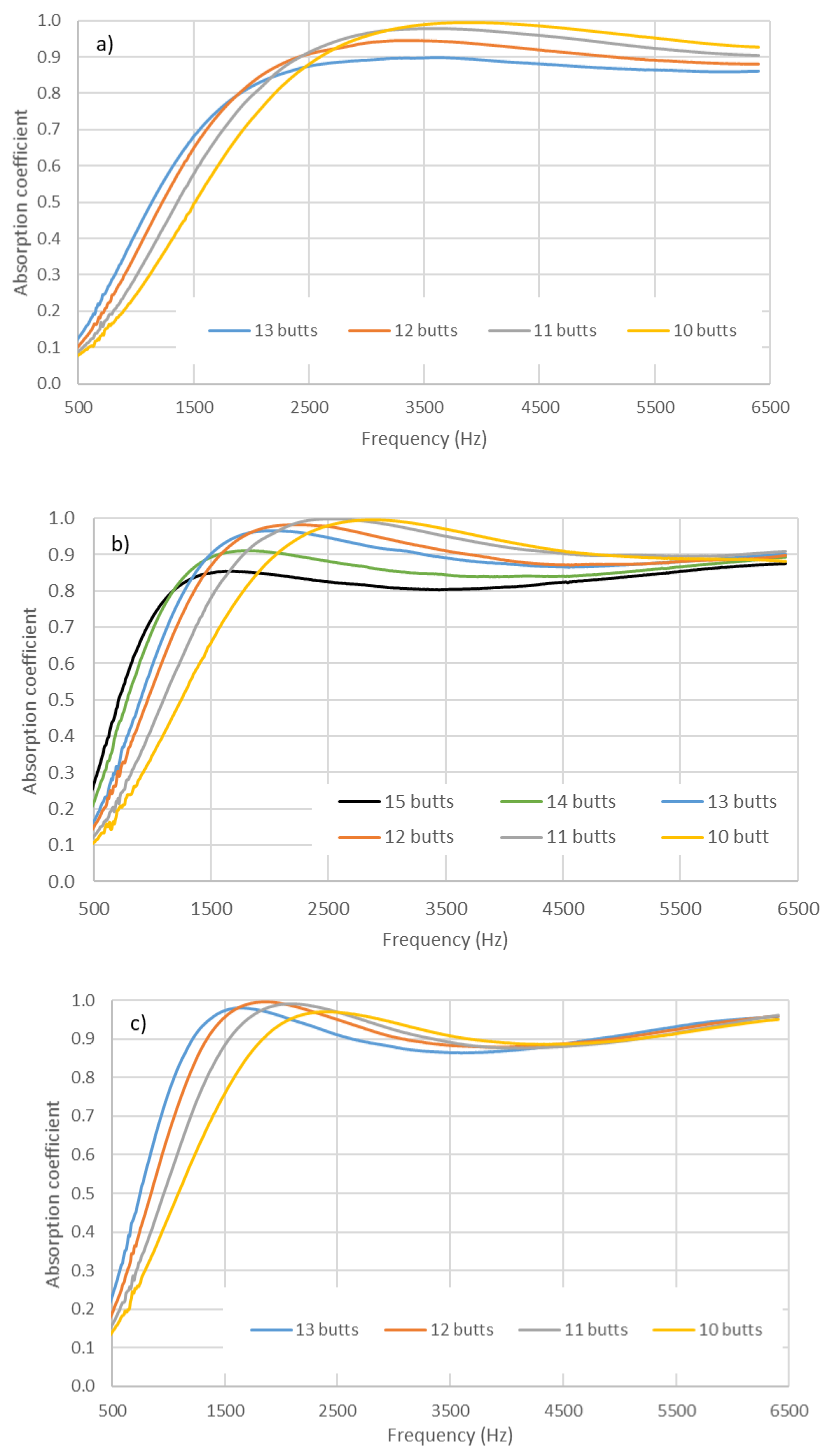
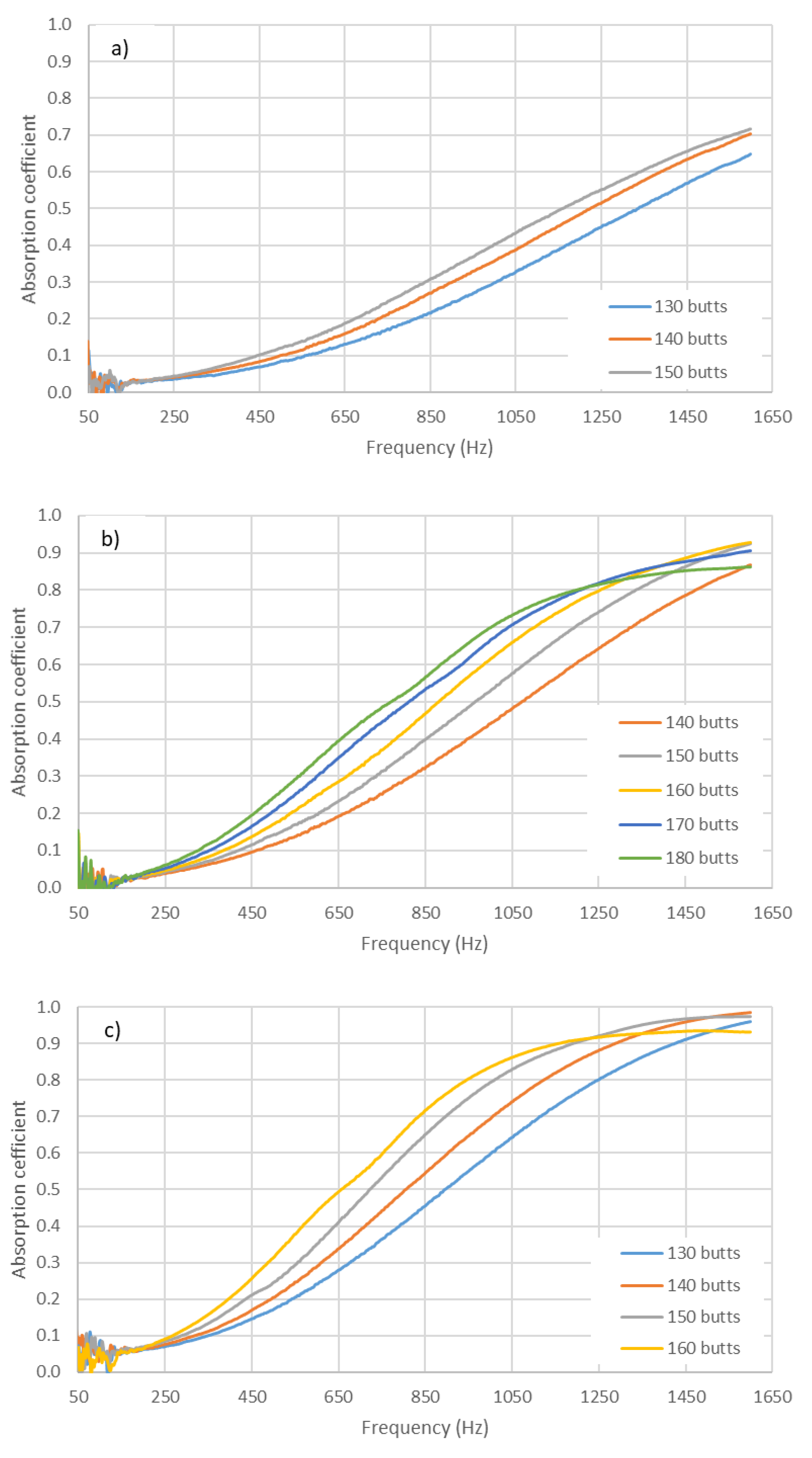

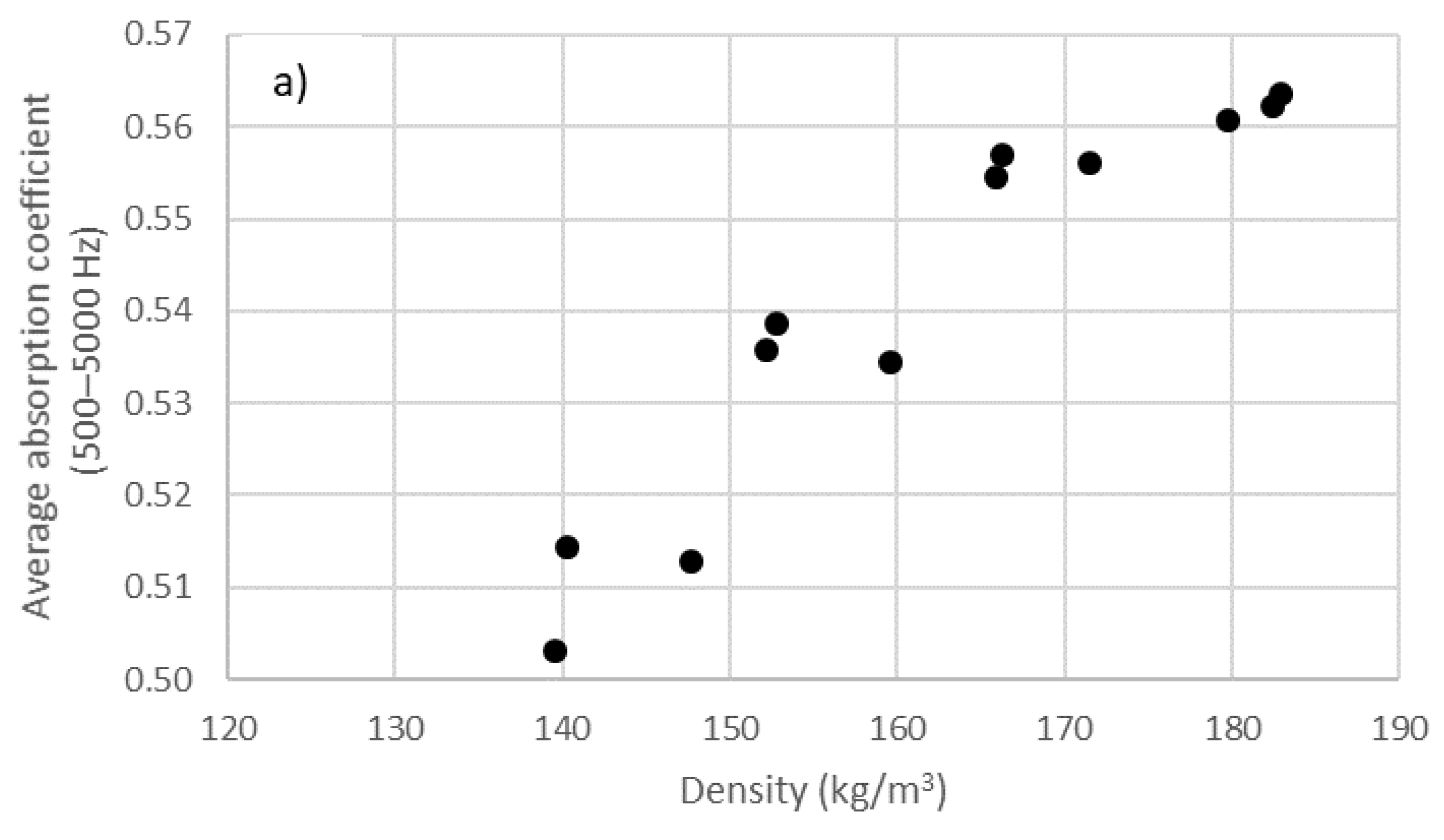
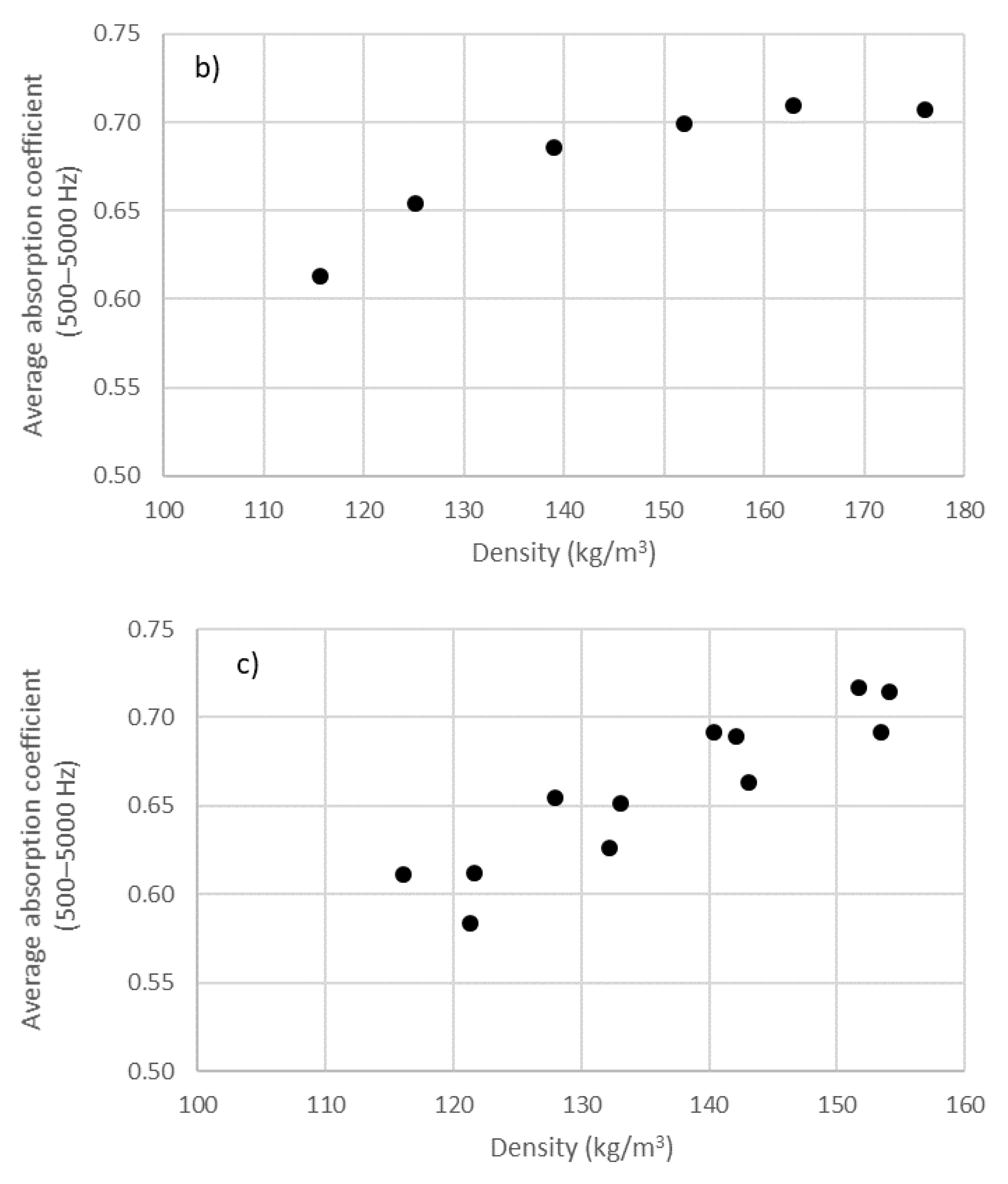
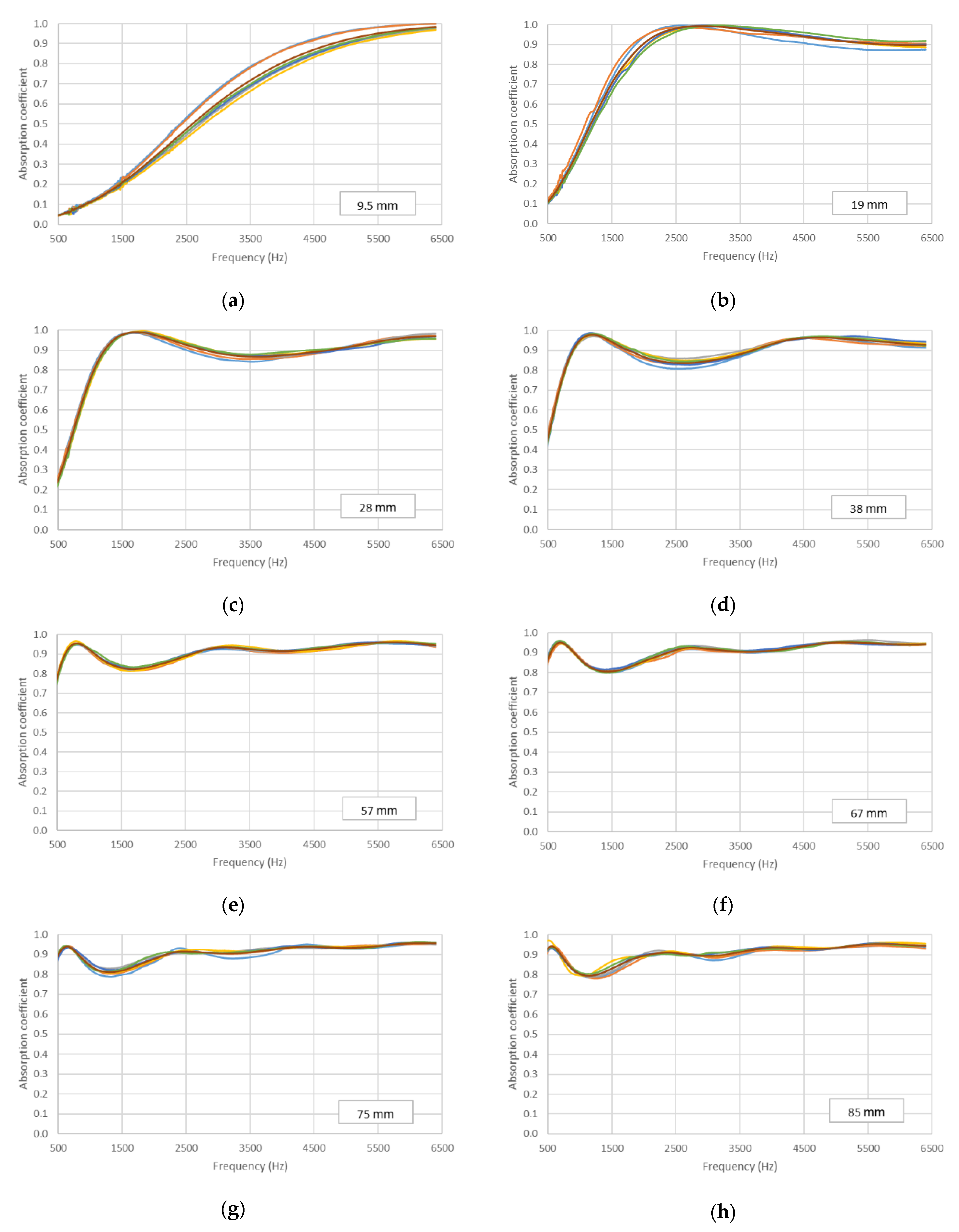
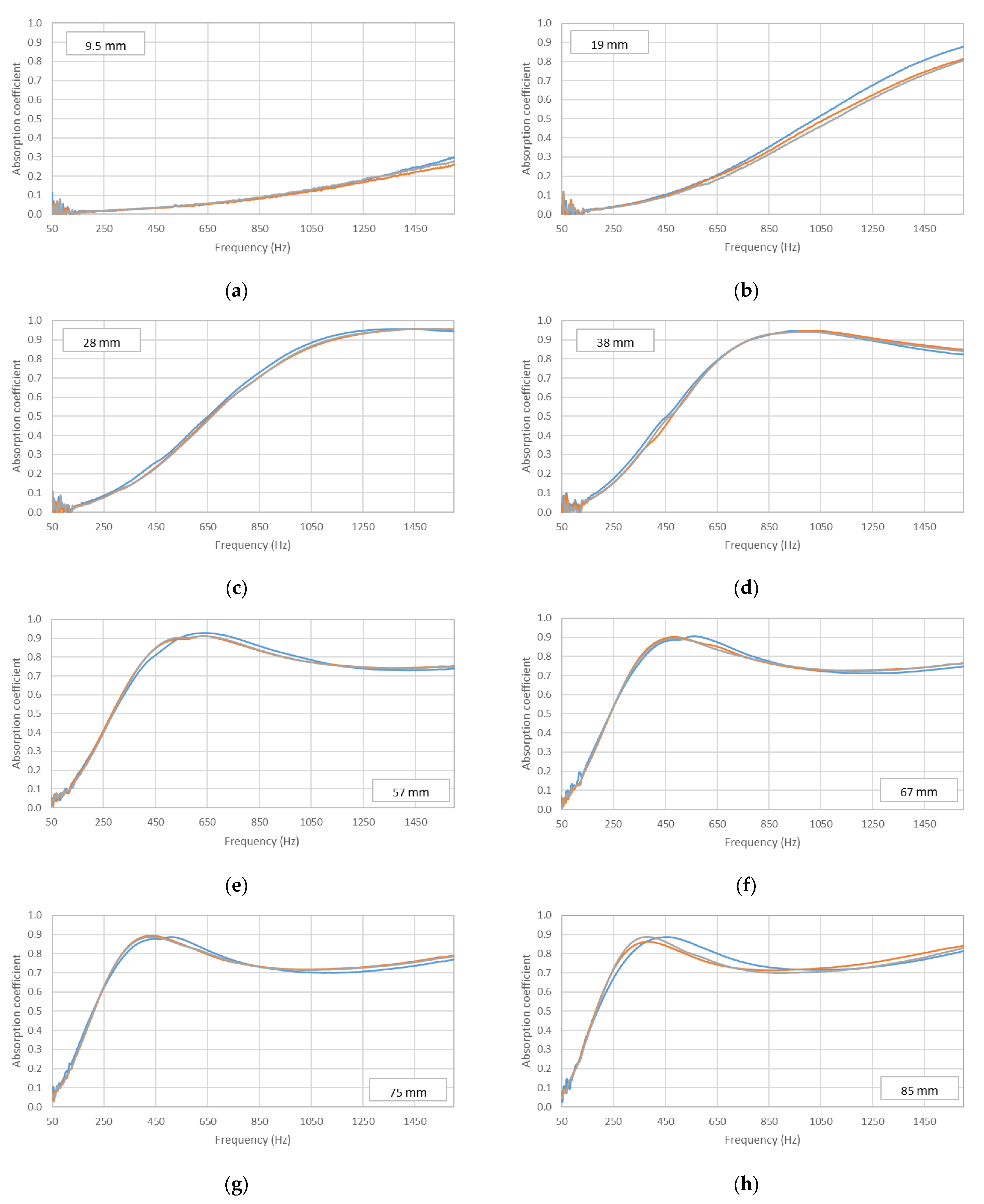
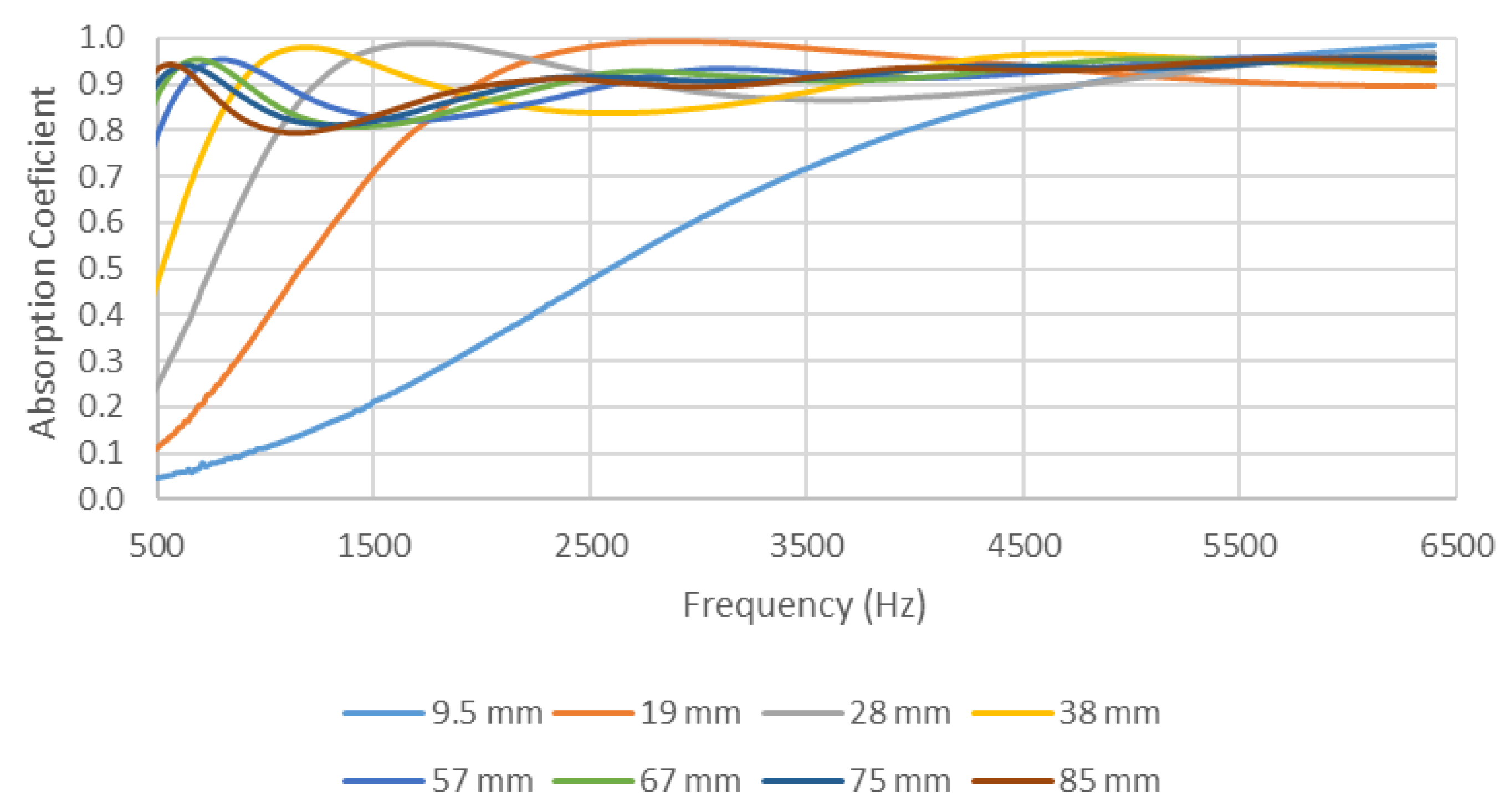

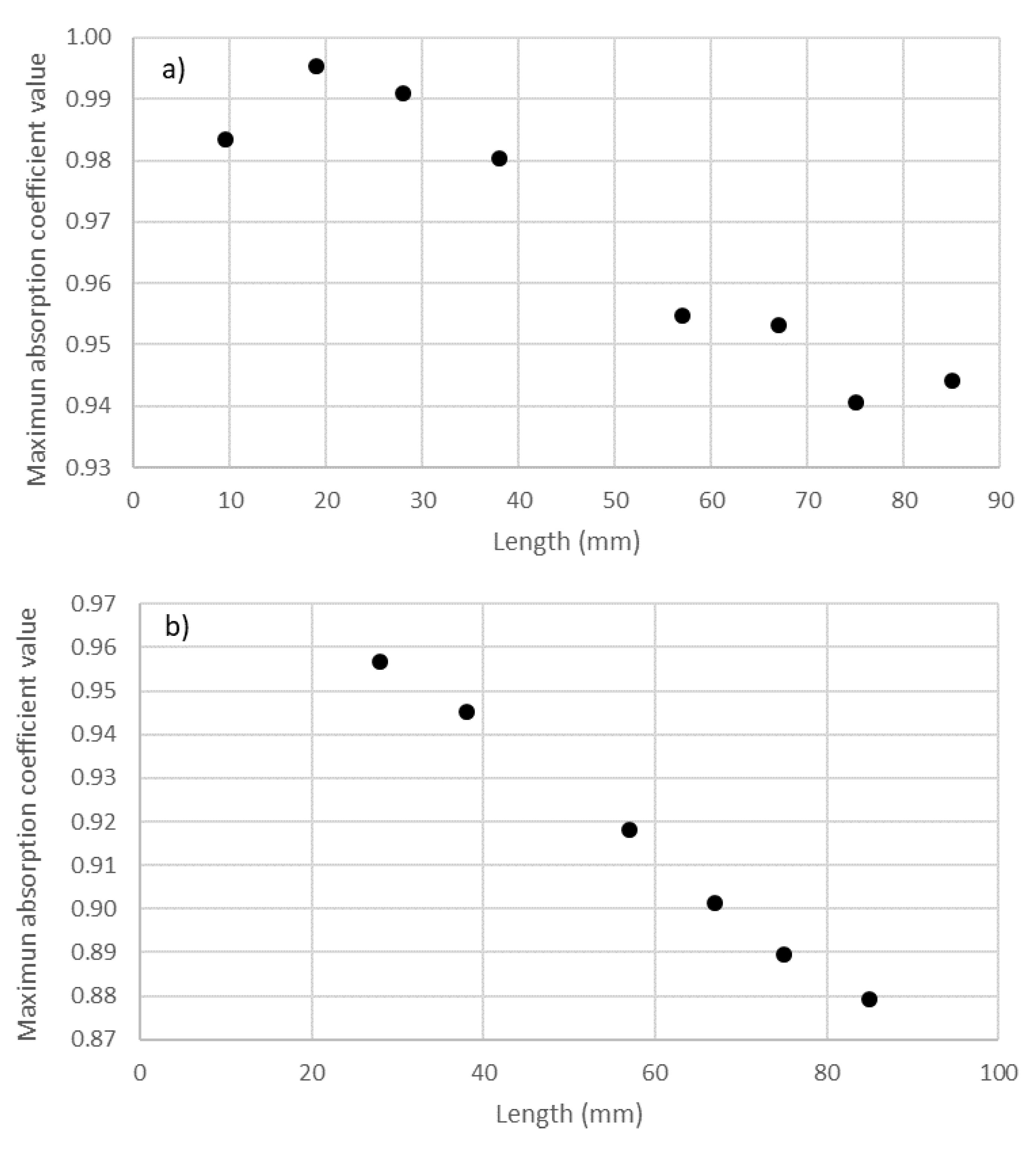
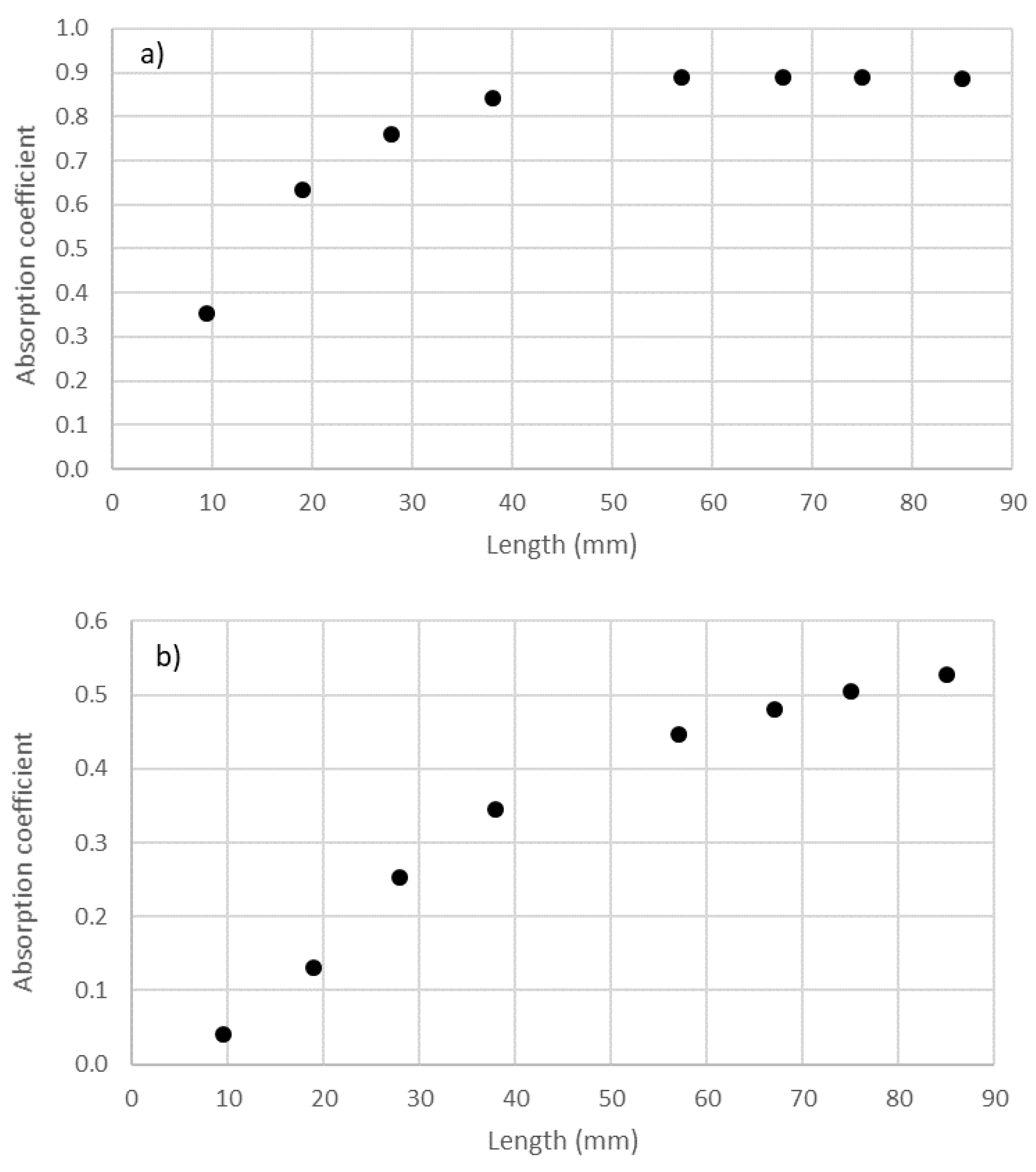

| Sample Number (29 mm Holder) | Average Length (mm) | Average Diameter (mm) | Range of Butts | Range of Density (kg/m3) |
| 12 | 14.2 ± 0.8 | 8.04 ± 0.08 | 10–13 | 141–186 |
| 6 | 20.8 ± 0.4 | 7.86 ± 0.12 | 10–15 | 116–176 |
| 12 | 26.6 ± 0.4 | 7.88 ± 0.13 | 10–13 | 117–154 |
| Sample Number (100 mm holder) | Average Length (mm) | Average Diameter (mm) | Range of Butts | Range of Density (kg/m3) |
| 9 | 14.3 ± 0.8 | 8.00 ± 0.12 | 130–150 | 156–182 |
| 5 | 20.8 ± 0.2 | 7.88 ± 0.05 | 140–180 | 138–179 |
| 7 | 26.4 ± 0.7 | 7.83 ± 0.18 | 130–160 | 132–163 |
Publisher’s Note: MDPI stays neutral with regard to jurisdictional claims in published maps and institutional affiliations. |
© 2021 by the authors. Licensee MDPI, Basel, Switzerland. This article is an open access article distributed under the terms and conditions of the Creative Commons Attribution (CC BY) license (https://creativecommons.org/licenses/by/4.0/).
Share and Cite
Gómez Escobar, V.; Moreno González, C.; Rey Gozalo, G. Analysis of the Influence of Thickness and Density on Acoustic Absorption of Materials Made from Used Cigarette Butts. Materials 2021, 14, 4524. https://doi.org/10.3390/ma14164524
Gómez Escobar V, Moreno González C, Rey Gozalo G. Analysis of the Influence of Thickness and Density on Acoustic Absorption of Materials Made from Used Cigarette Butts. Materials. 2021; 14(16):4524. https://doi.org/10.3390/ma14164524
Chicago/Turabian StyleGómez Escobar, Valentín, Celia Moreno González, and Guillermo Rey Gozalo. 2021. "Analysis of the Influence of Thickness and Density on Acoustic Absorption of Materials Made from Used Cigarette Butts" Materials 14, no. 16: 4524. https://doi.org/10.3390/ma14164524
APA StyleGómez Escobar, V., Moreno González, C., & Rey Gozalo, G. (2021). Analysis of the Influence of Thickness and Density on Acoustic Absorption of Materials Made from Used Cigarette Butts. Materials, 14(16), 4524. https://doi.org/10.3390/ma14164524







